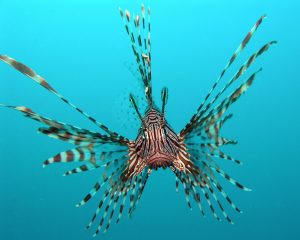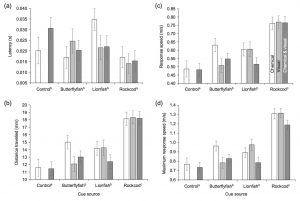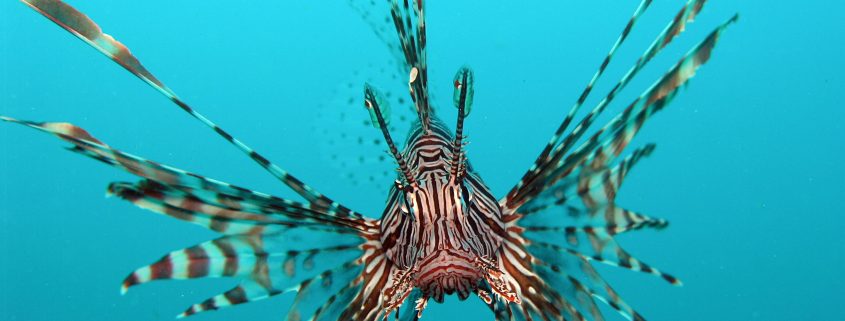Sneaky Predators
By Arina Favilla, SRC intern
“Everything you see exists together in a delicate balance, ” Mufasa wisely tells Simba in The Lion King right before a pouncing lesson. This is true of any ecosystem on the planet—the sun provides energy for plants to grow, plants are grazed on by herbivores, who are eaten by consumers, who are prey to other predators. Any prey-predator imbalance can have cascading effects on the entire ecosystem, particularly when invasive predators are especially sneaky predators, beating Simba in the element of surprise.
The element of surprise is difficult to accomplish in the aquatic environment because there are several cues (smell, sight, vibrations) that warn prey of a nearby predator and illicit a fast-start response, allowing them to get as far away as quickly as possible. It is debated whether this fast-start response is an autonomic response, similar to a knee-jerk reflex, or whether an individual can optimize their escape response in accordance to the threat.

Image of the red lionfish (Pterois volitans) displaying its characteristic fins and venomous spines. (From Wikimedia Commons)
McCormick and Allan (2016) investigated the red lionfish’s (Pterois volitans) success as a predator by determining the response of prey. The red lionfish, native to the Pacific Ocean, is a threatening invasive species in the Caribbean because of their success as predators easily devouring 8-10% of their body weight each day. They quickly decimate reef fish populations and destroy the delicate balance of a reef ecosystem. Moreover, recent research suggests lionfish are successful, sneaky predators by avoiding associative learning, a survival mechanism that allows prey to associate cues with dangerous predators leading to effective fast-start responses and successful escapes.
The study compared the response of whitetail damselfish to two predators, the red lionfish and the common rockcod, as well as a non-predator fish, the three-lined butterflyfish. First, the damselfish were conditioned to associate potential risk with the sight and odor of the two predator species coupled with chemical alarm cues. Previous studies have shown tropical fish species, including damselfish, can quickly learn to associate cues of a predator as a threat. Damselfish were then exposed to olfactory cues (seawater from the predator or non-predator tank) and/or visual cues (predator or non-predator tank placed adjacent to the damselfish tank) before being startled by a stimulus (release of a metal weight at the water’s surface) to provoke the fast-start response.

Comparison of the different aspects of the damselfish’s fast-start response when forewarned through chemical (white), visual (light grey), or a combination of cues (dark grey) of either one of two predators (red lionfish or rockcod), a non-predator (butterflyfish), or controls. The optimal fast-start response would have a short response latency time, high average response speed and maximum speed, and large distance travelled. Damselfish exposed to controls had the lowest response while those exposed to the rockcod had the highest response. Both the butterflyfish and lionfish elicited similar intermediate responses. (McCormick and Allan 2016)
McCormick and Allan (2016) found that the damselfish had greater fast-start responses when forewarned about the predatory rockcod through olfactory or visual cues, but showed similar ineffective fast-start responses—slow to react and slower speeds—when exposed to the cues for the lionfish as well as the non-predator butterflyfish and controls (Figure 2). In other words, the damselfish misidentify the lionfish as a non-predator, reducing its chance of escape if attacked. These results suggest that lionfish are capable of circumventing associative learning, leading to higher success rates in attacking prey. The findings of this study begin to explain the success of lionfish as predators, but further studies are required to better understand the mechanisms lionfish use to avoid forewarning of prey.
Works cited
McCormick, M. I. and B. J. M. Allan. 2016. Lionfish misidentification circumvents an optimized escape response by prey. Conservation Physiology 4:1–9.




Leave a Reply
Want to join the discussion?Feel free to contribute!